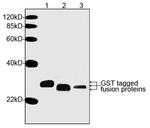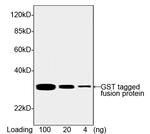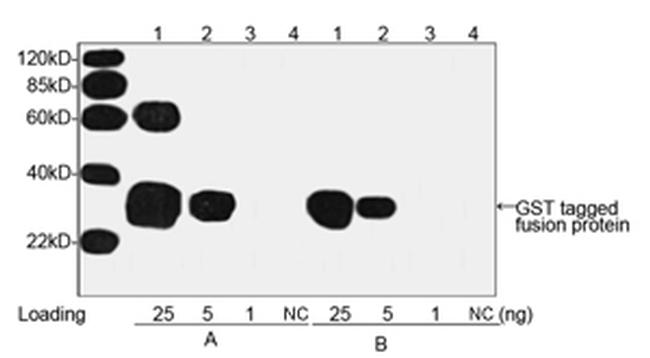Product References
Blue light-dependent interactions of CRY1 with GID1 and DELLA proteins regulate gibberellin signaling and photomorphogenesis in Arabidopsis.
The Plant cell
Xu P,Chen H,Li T,Xu F,Mao Z,Cao X,Miao L,Du S,Hua J,Zhao J,Guo T,Kou S,Wang W,Yang HQ
Cryptochromes are blue light photoreceptors that mediate various light responses in plants and mammals. In Arabidopsis (Arabidopsis thaliana), cryptochrome 1 (CRY1) mediates blue light-induced photomorphogenesis, which is characterized by reduced hypocotyl elongation and enhanced anthocyanin production, whereas gibberellin (GA) signaling mediated by the GA receptor GA-INSENSITIVE DWARF1 (GID1) and DELLA proteins promotes hypocotyl elongation and inhibits anthocyanin accumulation. Whether CRY1 co
Fri Aug 13 00:00:00 EDT 2021
The G Protein-Coupled Receptor FFAR2 Promotes Internalization during Influenza A Virus Entry.
Journal of virology
Wang G,Jiang L,Wang J,Zhang J,Kong F,Li Q,Yan Y,Huang S,Zhao Y,Liang L,Li J,Sun N,Hu Y,Shi W,Deng G,Chen P,Liu L,Zeng X,Tian G,Bu Z,Chen H,Li C
Influenza A virus (IAV) co-opts numerous host factors to complete its replication cycle. Here, we identified free fatty acid receptor 2 (FFAR2) as a cofactor for IAV entry into host cells. We found that downregulation of FFAR2 or Ffar2 expression significantly reduced the replication of IAV in A549 or RAW 264.7 cells. The treatment of A549 cells with FFAR2 siRNA or the FFAR2 pathway agonists 4-CMTB and compound 58 [Cmp 58; (S)-2-(4-chlorophenyl)-3,3-dimethyl-N-(5-phenylthiazol-2-yl)butanamide],
Mon Jan 06 00:00:00 EST 2020
Molecular cloning and functional characterization of Physcomitrella patens UBC13-UEV1 genes required for Lys63-linked polyubiquitination.
Plant science : an international journal of experimental plant biology
Guo H,Wang L,Hu R,He Y,Xiao W
Ubc13 and Ubc/E2 variant (Uev) form a stable heterodimer to mediate Lys63-linked polyubiquitination. Unicellular eukaryotic genomes often contain single UBC13 and UEV gene; however, multiple homologs were found in higher plants. As initial land plants, Physcomitrella patens occupies a key evolutionary position between green algae and higher plants. In this study, we report the identification and functional characterization of two UBC13 and three UEV1 genes from P. patens. Both PpUbc13s form hete
Sat Aug 01 00:00:00 EDT 2020
Post-transcriptional regulation of Ghd7 protein stability by phytochrome and OsGI in photoperiodic control of flowering in rice.
The New phytologist
Zheng T,Sun J,Zhou S,Chen S,Lu J,Cui S,Tian Y,Zhang H,Cai M,Zhu S,Wu M,Wang Y,Jiang L,Zhai H,Wang H,Wan J
Rice (Oryza sativa) is a facultative short-day (SD) plant, flowering early under SD and late under long-day (LD) conditions. Ghd7 is a major regulator of flowering time in rice, which strongly delays flowering under LD. Induction of Ghd7 expression by phytochromes has been shown to contribute to photoperiodic regulation of flowering in rice. Here, we show that Ghd7 also is regulated by phytochromes at a post-transcriptional level. We found that constitutive expression of Ghd7 delays flowering in
Tue Oct 01 00:00:00 EDT 2019
Carbon nanotubes as molecular transporters to study a new mechanism for molecular entry into the cell nucleus using actin polymerization force.
PloS one
Sadr Karimi S,Pante N
The transport of macromolecules into the cell nucleus occurs through nuclear pore complexes (NPCs) and is mediated by cellular receptors. Recently a novel mechanism of nuclear entry in which actin polymerization provides a propulsive force driving the transport through the NPC has been proposed. This mechanism is used by the nucleocapsid from baculovirus one of the largest viruses to replicate in the nucleus of their host cells which crosses the NPC and enters the nucleus independently of cellul
Tue Mar 03 00:00:00 EST 2020
N-terminal methionine excision of proteins creates tertiary destabilizing N-degrons of the Arg/N-end rule pathway.
The Journal of biological chemistry
Nguyen KT,Kim JM,Park SE,Hwang CS
All organisms begin protein synthesis with methionine (Met). The resulting initiator Met of nascent proteins is irreversibly processed by Met aminopeptidases (MetAPs). N-terminal (Nt) Met excision (NME) is an evolutionarily conserved and essential process operating on up to two-thirds of proteins. However the universal function of NME remains largely unknown. MetAPs have a well-known processing preference for Nt-Met with Ala Ser Gly Thr Cys Pro or Val at position 2 but using CHX-chase assays to
Fri Mar 22 00:00:00 EDT 2019
Porcine Mx1 Protein Inhibits Classical Swine Fever Virus Replication by Targeting Nonstructural Protein NS5B.
Journal of virology
Zhou J,Chen J,Zhang XM,Gao ZC,Liu CC,Zhang YN,Hou JX,Li ZY,Kan L,Li WL,Zhou B
Mx proteins are interferon (IFN)-induced GTPases that have broad antiviral activity against a wide range of RNA and DNA viruses; they belong to the dynamin superfamily of large GTPases. In this study we confirmed the anti-classical swine fever virus (CSFV) activity of porcine Mx1 and showed that porcine Mx2 (poMx2) human MxA (huMxA) and mouse Mx1 (mmMx1) also have anti-CSFV activity Small interfering RNA (siRNA) experiments revealed that depletion of endogenous poMx1 or poMx2 enhanced CSFV rep
Sun Apr 01 00:00:00 EDT 2018
The AMSH3 ESCRT-III-Associated Deubiquitinase Is Essential for Plant Immunity.
Cell reports
Schultz-Larsen T,Lenk A,Kalinowska K,Vestergaard LK,Pedersen C,Isono E,Thordal-Christensen H
Plant "nucleotide-binding leucine-rich repeat" receptor proteins (NLRs) detect alterations in host targets of pathogen effectors and trigger immune responses. The Arabidopsis thaliana mutant pen1 syp122 displays autoimmunity, and a mutant screen identified the deubiquitinase "associated molecule with the SH3 domain of STAM3" (AMSH3) to be required for this phenotype. AMSH3 has previously been implicated in ESCRT-mediated vacuolar targeting. Pathology experiments show that AMSH3 activity is&
Tue Nov 27 00:00:00 EST 2018
JMJD5 cleaves monomethylated histone H3 N-tail under DNA damaging stress.
EMBO reports
Shen J,Xiang X,Chen L,Wang H,Wu L,Sun Y,Ma L,Gu X,Liu H,Wang L,Yu YN,Shao J,Huang C,Chin YE
The histone H3 N-terminal protein domain (N-tail) is regulated by multiple posttranslational modifications, including methylation, acetylation, phosphorylation, and by proteolytic cleavage. However, the mechanism underlying H3 N-tail proteolytic cleavage is largely elusive. Here, we report that JMJD5, a Jumonji C (JmjC) domain-containing protein, is a Cathepsin L-type protease that mediates histone H3 N-tail proteolytic cleavage under stress conditions that cause a DNA damage response. JMJD5 cli
Fri Dec 01 00:00:00 EST 2017
Adeno-associated Virus (AAV) Serotypes Have Distinctive Interactions with Domains of the Cellular AAV Receptor.
Journal of virology
Pillay S,Zou W,Cheng F,Puschnik AS,Meyer NL,Ganaie SS,Deng X,Wosen JE,Davulcu O,Yan Z,Engelhardt JF,Brown KE,Chapman MS,Qiu J,Carette JE
Adeno-associated virus (AAV) entry is determined by its interactions with specific surface glycans and proteinaceous receptor(s). Adeno-associated virus receptor (AAVR; also named KIAA0319L) is an essential cellular receptor required for the transduction of vectors derived from multiple AAV serotypes including the evolutionary distant serotypes AAV2 and AAV5. Here we further biochemically characterize the AAV-AAVR interaction and define the domains within the ectodomain of AAVR that facilitate t
Fri Sep 15 00:00:00 EDT 2017
Phosphorylation of LSD1 by PLK1 promotes its chromatin release during mitosis.
Cell & bioscience
Peng B,Shi R,Jiang W,Ding YH,Dong MQ,Zhu WG,Xu X
Lysine-specific histone demethylase 1 (LSD1) modulates chromatin status through demethylation of H3K4 and H3K9. It has been demonstrated that LSD1 is hyperphosphorylated and dissociates from chromatin during mitosis. However the molecular mechanism of LSD1 detachment is unknown.
Thu Oct 01 00:00:00 EDT 2020
Allosteric activation of the RNF146 ubiquitin ligase by a poly(ADP-ribosyl)ation signal.
Nature
DaRosa PA,Wang Z,Jiang X,Pruneda JN,Cong F,Klevit RE,Xu W
Protein poly(ADP-ribosyl)ation (PARylation) has a role in diverse cellular processes such as DNA repair, transcription, Wnt signalling, and cell death. Recent studies have shown that PARylation can serve as a signal for the polyubiquitination and degradation of several crucial regulatory proteins, including Axin and 3BP2 (refs 7, 8, 9). The RING-type E3 ubiquitin ligase RNF146 (also known as Iduna) is responsible for PARylation-dependent ubiquitination (PARdU). Here we provide a structural basis
Thu Jan 08 00:00:00 EST 2015
A molecular ruler regulates cytoskeletal remodelling by the Rho kinases.
Nature communications
Truebestein L,Elsner DJ,Fuchs E,Leonard TA
The Rho-associated coiled-coil kinases (ROCK) are essential regulators of the actin cytoskeleton; however, the structure of a full-length ROCK is unknown and the mechanisms by which its kinase activity is controlled are not well understood. Here we determine the low-resolution structure of human ROCK2 using electron microscopy, revealing it to be a constitutive dimer, 120nm in length, with a long coiled-coil tether linking the kinase and membrane-binding domains. We find, in contrast to previous
Tue Dec 01 00:00:00 EST 2015
HERC2/USP20 coordinates CHK1 activation by modulating CLASPIN stability.
Nucleic acids research
Zhu M,Zhao H,Liao J,Xu X
CLASPIN is an essential mediator in the DNA replication checkpoint, responsible for ATR (ataxia telangiectasia and Rad3-related protein)-dependent activation of CHK1 (checkpoint kinase 1). Here we found a dynamic signaling pathway that regulates CLASPIN turn over. Under unperturbed conditions, the E3 ubiquitin ligase HERC2 regulates the stability of the deubiquitinating enzyme USP20 by promoting ubiquitination-mediated proteasomal degradation. Under replication stress, ATR-mediated phosphorylati
Mon Dec 01 00:00:00 EST 2014
BCL10 regulates RNF8/RNF168-mediated ubiquitination in the DNA damage response.
Cell cycle (Georgetown, Tex.)
Zhao H,Zhu M,Dou G,Zhao H,Zhu B,Li J,Liao J,Xu X
Timely and proper cellular response to DNA damage is essential for maintenance of genome stability and integrity. B-cell lymphoma/leukemia 10 (BCL10) facilitates ubiquitination of NEMO in the cytosol, activating NFκB signaling. Translocation and/or point mutations of BCL10 associate with mucosa-associated lymphoid tissue lymphomas and other malignancies. However, the mechanisms by which the resulting aberrant expression of BCL10 leads to cellular oncogenesis are poorly understood. In this
Mon Jan 12 00:00:00 EST 2015
A conserved Mediator-CDK8 kinase module association regulates Mediator-RNA polymerase II interaction.
Nature structural & molecular biology
Tsai KL,Sato S,Tomomori-Sato C,Conaway RC,Conaway JW,Asturias FJ
The CDK8 kinase module (CKM) is a conserved, dissociable Mediator subcomplex whose component subunits were genetically linked to the RNA polymerase II (RNAPII) C-terminal domain (CTD) and individually recognized as transcriptional repressors before Mediator was identified as a pre-eminent complex in eukaryotic transcription regulation. We used macromolecular EM and biochemistry to investigate the subunit organization, structure and Mediator interaction of the Saccharomyces cerevisiae CKM. We fou
Wed May 01 00:00:00 EDT 2013
Structural basis for endosomal trafficking of diverse transmembrane cargos by PX-FERM proteins.
Proceedings of the National Academy of Sciences of the United States of America
Ghai R,Bugarcic A,Liu H,Norwood SJ,Skeldal S,Coulson EJ,Li SS,Teasdale RD,Collins BM
Transit of proteins through the endosomal organelle following endocytosis is critical for regulating the homeostasis of cell-surface proteins and controlling signal transduction pathways. However, the mechanisms that control these membrane-transport processes are poorly understood. The Phox-homology (PX) domain-containing proteins sorting nexin (SNX) 17, SNX27, and SNX31 have emerged recently as key regulators of endosomal recycling and bind conserved Asn-Pro-Xaa-Tyr-sorting signals in transmemb
Tue Feb 19 00:00:00 EST 2013
The Kaposi's sarcoma-associated herpesvirus ORF34 protein binds to HIF-1α and causes its degradation via the proteasome pathway.
Journal of virology
Haque M,Kousoulas KG
Kaposi's sarcoma-associated herpesvirus (KSHV) is the causative agent for Kaposi's sarcoma (KS) and two other lymphoproliferative disorders, primary effusion lymphoma (PEL) and multicentric Castleman's disease (MCD). Kaposi's sarcoma is a highly vascular tumor, and recently both hypoxia-inducible factor 1α (HIF-1α) and HIF-2α were detected in KS samples, indicating a role of HIFs in the KSHV life cycle. Previously, we showed that ORF34, a lytic gene of unass
Fri Feb 01 00:00:00 EST 2013
Identification and characterization of a novel endogenous murine parkin mutation.
Journal of neurochemistry
Ramsey CP,Giasson BI
Various mutations in the PARK2 gene which encodes the protein, parkin, are causal of a disease entity-termed autosomal recessive juvenile parkinsonism. Parkin can function as an E3 ubiquitin-protein ligase, mediating the ubiquitination of specific targeted proteins and resulting in proteasomal degradation. Parkin is thought to lead to parkinsonism as a consequence of a loss in its function. In this study, immunoblot analyses of brain extracts from Balb/c, C57BL/6, C3H, and 129S mouse strains dem
Thu Apr 01 00:00:00 EDT 2010






